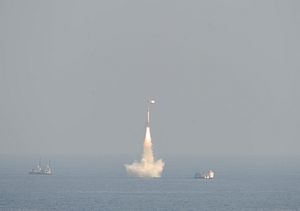Recently, India secretly tested its most advanced submarine-launched ballistic missile (SLBM) to date. The K-4 SLBM gives India the ability to strike a land target 3,000 km away from an undersea firing platform and is a significant boon to India’s nuclear weapons program, extending India’s ability to credibly deter a nuclear-armed rival from attacking first. A robust sea-based deterrent is necessary to field a credible second-strike capability and the K-4 SLBM does just that.
According to The Hindu, the K-4 was tested on March 24, 2014, a few weeks shy of the 16th anniversary of India’s controversial 1998 Pokhran-II nuclear tests. The test went off without a hitch:
The launch took place from a pontoon submerged more than 30 metres deep in the sea off the Visakhapatnam coast. After a powerful gas generator ejected it from the pontoon submerged in the Bay of Bengal, the K-4 missile rose into the air, took a turn towards the designated target, sped across 3,000 km in the sky and dropped into the Indian Ocean.
The K-4 SLBM was one of India’s Defense Research and Development Organization’s (DRDO) most secretive projects and is intended to succeed the K-15 underwater-launched ballistic missile. Once fully tested and proven to be reliable, the K-4 will be installed on India’s new INS Arihant — its first indigenously developed nuclear submarine.
The K-4 is tailor-made for second-strike purposes. According to the New Indian Express, the missile has the advantage of a hypersonic cruise speed and uses an innovative system of weaving in three dimensions as it flies towards its target, making it an exceptionally difficult target for anti-ballistic missile systems and other air defense systems. Other features of the K-4 include its high accuracy, with an alleged near-zero circular error probable (CEP).
The abilities of the K-4 are set to allow India to deter China with greater credibility. While Pakistan is a concern for India, its relative lack of strategic depth and India’s massive conventional advantage have pushed Indian thinking on nuclear matters towards China in recent year. With the K-4-equipped INS Arihant, India has a survivable second-strike capability against China. The Arihant can reportedly carry four K-4 missiles (or 12 of the less-advanced K-15 missiles). The first Arihant-class submarine is undergoing sea trials in 2014 and will be succeeded by three additional boats, expected to be in commission by 2023.
India’s credible minimum deterrence doctrine, with a no-first use (NFU) caveat, may be subject to revision if a BJP-led government comes to power this year (a highly likely development). As of now, the specifics of the BJP’s ambitions remain ambiguous but India’s proximity to fielding a credible nuclear triad with a survivable second-strike capability could make NFU revision less urgent.
































